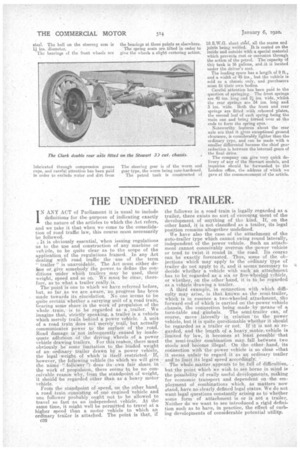THE UNDEFINED TRAILER.
Page 18

If you've noticed an error in this article please click here to report it so we can fix it.
IN ANY ACT of Parliament it is usual to include definitions for the purpose of indicating exactly the nature of the articles to which the Act refers, and we take it that when we come to the consolidation of road traffic law, this course must necessarily be followed.
.. It is obviously essential, when issuing regulations as to the use and construction of any machine or veh:inle, to be quite clear as to the scope of the application of the regulations framed. In any Act dealing with road traffic the -use of the term "
trailer" is unavoidable. The Act must either define of, give somebody' the power. to define the conditions underwhich trailers may be used, their weight, sPeed and .so on. • We must be clear, there
fore, as to what a trailer really is. .
The point is one to which we have referred before, but, so far as we are aware, no progress has been made towards its elucidation. No one seems to be quite certain-whether a carrying unit of a road train, bearing some share in the work of propulsion of the whole train, is to be regarded as a .trailer. We imagine that "strictly speaking, a trailer is a vehicle which merely trails behind a power vehicle. A unitof a road train 'does not merely. trail, but actually communicates power to the 5ur1ace of the road. Road damage is not infrequently, caused by inadequate adhesion . of the driving wheels of a power vehicle drawing trailers. For this reaton, there must obviously besome limitation to the, loaded weight of anordinary trailer drawn by a power vehicle, the legal weight of whichis itself restricted.— If, however, the following vehicle (to which we will give the name " folloWer ") does its own fair share, in the work of propulsion, there seerns tq be no conceivable reason why, from the standpoint of weight, it should be regarded other than as a heavy motor vehicle.
From the standpoint of speed, on the other hand, a road train consisting of one engined vehicle and one follower probably ought not to be allowed to travel so fast as an independent vehicle. At the same time, it might well be permitted to travel at a higher speed than a motor vehicle to which an ordinary trailer is attacjied. The point is that, if 0-32
the follower in a road train is legally regarded as a trailer, there exists no sort of encourag Talent of the development of anything of the kind. If, on the other hand, it is not classified as a trailer, its legal position remains altogether undefined.
We have also the case of the attachment of the auto-trailer type which cannot swing round laterally, independent of the power vehicle. Such an attachment cannot conceivably overrun the -power vehicie
or tend to twist it round in . the road, Its course can be exactly forecasted. Thus, some of the objections which may apply to the ordinary type of
trailer do not apply to it, and it seems 'necessary to decide whether a vehicle with such an attachment has to be regarded as 'a six or five-Wheele,d vohicle, or whether, on the other hand, it is to, be regarded
as a vehicle drawing a trailer.
A third example, in connection with which diffic,ulty may arise, is that: knoWn as the Semi-trailer,
which is in essence a two-wheeled attachment,. the forward end of which is carried on the power vehicle .chassis, the connection being made by means -of a turn-table and gimbals. The semi-trailer can of
course, move laterally in relation to the power vehicle, but it is quite questionable whetherit should
be re.garded as a trailer Or not If it is not so re garded, and the length of a heavy motor, vehicle is limited 'by law, it becomes at least possible that the semi trailer combination may fail betWeen two stools and become illegal. On the other hand, its connection with the power vehicle is so close .that it seems unfair to regard it as an ordinary trailer and to limit its legal speed accordingly. '
The whole matter appears to be full of difficulties, but the point which we wish to See borne in mind is the possibility of really usefuldevelopments, making for economic transport and dependent cm the employment of combinations which, as matters now stand, have no clearlY defined legal status. We do not want legal questions constantly arising as to whether some form of attachment is or is not a trailer. Neither do we want to see introduced a rigid definition such as to have, in practice, the effect of curbing developments of considerable potential utility.


























